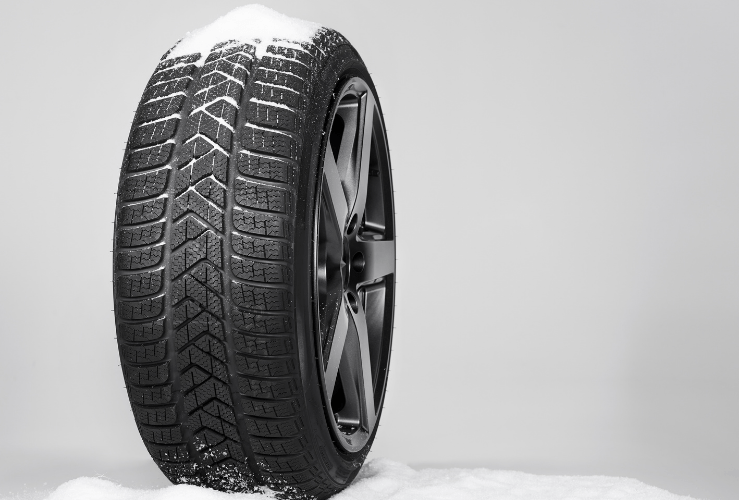What are winter tyres?
Winter tyres – or ‘cold weather tyres’ as they are technically known – are designed specifically to be used in colder, wet, icy or snowy conditions.
Do you need winter tyres in the UK?
Unlike in some other countries, it is not a legal requirement to change to winter tyres in the UK during the colder months.
However, in the UK winter tyres have become increasingly in demand over the last few winters, following icy conditions that brought many a vehicle to a standstill.
But winter tyres are useful for more than just icy or snowy conditions. In fact, they are designed for temperatures below 7ºC.
But what makes winter tyres so effective?

Key features of winter tyres
Additional, wider, deeper grooves
The grooves of a tyre and specifically designed to drain and expel water from underneath the tyre, to prevent a vehicle from aquaplaning.
Deeper grooves in a winter tyre allow for water to be cleared better and the risk of aquaplaning is reduced thanks to the higher groove-to-rubber ratio.
In snowy weather these additional, deeper grooves are also more effective at displacing the snow and slush from the roads surface, allowing the rubber compound on the tyre to continue gripping the road properly.
The deeper grooves of a winter tyre fill with snow, which then sticks to the snow on the road, providing traction.
More sipes
Cold weather tyres also have many more sipes than normal tyres.
For example, Michelin’s winter tyres have around 1,500 sipes, while a normal tyre has around 200.
Sipes – thin small slots in a tyre tread - lock into icy and snowy roads, helping to improve traction.
In snowy conditions, as with the deeper groves of a winter tyre, the sipes fill with snow helping to improve contact with the ground.
More silica
Winter weather tyres are produced from a different mixture (compound) of materials than standard/summer tyres.
Winter tyres are higher in silica, which means they remain softer, and can grip better in freezing temperatures than normal tyres can.
Summer tyres are less flexible in the cold, which can impact the effectiveness of the vehicle’s traction and braking capabilities.
Do winter tyres make a difference?
Yes, winter tyres can make a difference in colder conditions.
What are the benefits of winter tyres?
As we can see from above, winter / cold weather tyres can provide benefits during colder temperatures, in that:
- Winter tyres provide improved traction in compared to standard tyres.
- Improved braking distances in temperatures of 7º Celsius and below
What the experts say
The agency that promotes safe tyre use in the UK, TyreSafe, say that with winter tyres, their “tread and structure are designed to give better handling than normal tyres in slush and fresh or melting snow.”
Winter tyre sidewall markings
Winter-specific tyres are easy to spot, as they should bear the snow-topped mountain snowflake symbols on the sidewalls.
Three-Peak Mountain Snowflake symbol
The 3PMSF alpine symbol (Three-Peak Mountain Snowflake symbol) Is mandatory for winter or all-weather tyres produced since January 1, 2018.
To qualify for this marking, the tyre must have been tested according to a standardised regulatory method and to have performed to a satisfactory standard in terms of both mobility and safety on snow.
Tyres that feature the 3PMSF symbol must also be able to retain their performance at temperatures below zero.
M+S tyres
As well as cold weather tyres, there are also Mud and Snow tyres.
Tyres bearing the M+S marking do not require passing a certified test and is entirely up to the manufacturer. This means that tyre manufacturers can label a tyre M+S, even if it is not suitable for winter.
Are winter tyres more expensive?
Winter tyres are slightly more expensive than standard tyres and the cost of winter tyres can vary depending on the supplier and the type of car you own.
Different cars will require bigger and more expensive winter tyres than others.
However, they do offer the benefit of improved safety during the colder months.
When should I use winter tyres in the UK?
Winter tyres or cold weather tyres are of great benefit once the temperature falls below 7 degrees C.
Can you use winter tyres in summer?
Switching from your winter tyres to standard tyres in summertime is highly recommended.
Both types of tyre are specifically designed to provide optimal performance for the particular season of their intended use.
Reasons not to use winter tyres in summer:
- The softer tread of a winter tyre wears out a lot quicker on warm tarmac.
- The handling won't be as responsive as it should be in a critical situation.
- The stopping distance is extended.
According to Michelin, braking distance between 11ºC to 26ºC from 50mph on wet roads, will be 4m shorter with summer tyres than with a set of winter tyres.
On a dry road, braking from 31mph to zero, the braking distance will be 1.5m shorter on summer tyres than on winter tyres.
Do I need to tell my insurance company if I have fitted winter tyres?
Whilst most insurers do not require you to tell them that you have fitted winter tyres as long as they are 'correct for the vehicle and professionally fitted, some insurers do require that you inform before you make the switch.
Best practice is to double check with your own insurance company beforehand
The ABI has created a winter tyres ‘commitment’, which outlines further details of the implications to your insurance cover should you opt to switch to winter tyres.
Winter driving tips
Find out more about safe winter driving with our 11 Winter Car Protection Tips




